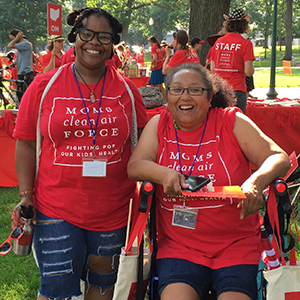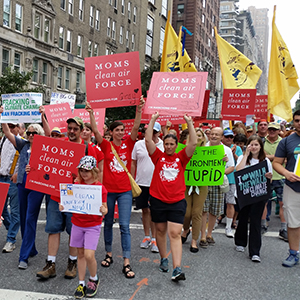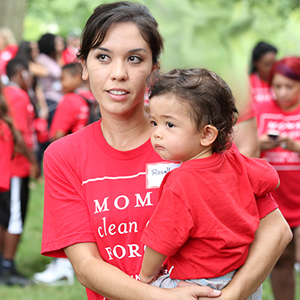
We’re riding high from our April 3 summit, “Plastics: A Health Crisis in Plain Sight.” (Watch the replay here.) In multiple panels over multiple hours, leading scientists, mental health experts, doctors, advocates, policymakers, and people living near extensive and heavily polluting plastics facilities discussed the latest research on the devastating impact of plastics on human health and the environment. We heard what plastic exposure does to our brain and bodies, why plastics recycling—including “advanced recycling,” a.k.a. burning plastics—is a false solution, and what we can actually do to tackle this mammoth problem.
Moms’ Dominique Browning set the stage in her remarks ahead of a panel discussion of the health impacts of everyday plastic exposure: “We are in a fight to protect the laws that set forth our right to clean air—and make it achievable. In other words, this fight is a significant part of a fight for a democracy that respects the rule of law.”
Tell Congress: Protect Families From the Plastics and Petrochemical Industry
Pennsylvania Congresswoman Summer Lee brought this fight home, when she announced at the end of the event her plans to launch a new caucus in Congress to “tackle this issue head on, to find solutions that work and are community rooted.” Sitting in the National Press Club room, her boundless energy and resolve bounced off the walls and was contagious.

If you weren’t able to join us in person or as one of the over 120,000 viewers online, here are five takeaways from our plastics summit. What’s amply clear is that people are deeply concerned about petrochemical pollution and also want better, safer solutions. We have work to do.
1. Plastic is causing a massive health crisis.
The effects of plastics on human health are horrific: There’s pretty much no health concern that isn’t linked to or made worse by plastics. “We have 16,000 chemicals used in plastic. 10,000 of them we have no information whatsoever about. That’s a crime,” said Dr. Leonardo Trasande, Director, NYU Center for the Investigation of Environmental Hazards.

Diseases and health harms linked to plastic mentioned by our panelists throughout the summit include: hormone disruption, sperm count decline, reduced pediatric brain size, attention deficit disorder, autism, metabolic disorders, various cancers, fatty liver disease, inflammatory diseases, oxidative stress, premature birth, cardiovascular disease, and even death. “50,000 Americans 55 to 64 die each year due to plastic exposure,” said Dr. Trasande.
The rise in chronic childhood illness “isn’t genetics; it’s linked to this increase in petrochemical produced plastic,” said Dr. Tracey Woodruff, professor and Director of UCSF’s Program on Reproductive Health and the Environment and EaRTH Center, adding, “The fossil fuel industry is making these chemicals. They’re profiting and are the driving factor of disease now.”
2. Plastic is a dangerous air pollutant.
It’s obvious that plastic is in, say, a water bottle. It’s less obvious that it’s polluting our air. But it is, and it’s hazardous—from production to incineration.
“We are very concerned with PM 2.5. That is the most dangerous form of particulate matter,” said Dr. Shannon Jones, professor of toxicology and biology at the University of Richmond. “Plastic production and plastic incineration contribute to the production of particulate matter.” PM 2.5, or soot pollution, can absorb plastic chemicals and then get deep inside of lungs, damaging airways and exacerbating pre-existing conditions.
Other chemicals that can be released when plastic is burned include persistent organic pollutants, such as dioxins and furans. “These can have impacts on every stage of life even before birth and all the way to the grave.”

3. “Pollution is a form of oppression.”
This is a direct quote from Dr. Jones, and many panelists throughout the summit echoed her statement. Not all populations have the same exposure to plastic chemicals, and many Black, Latino, Indigenous, and economically marginalized neighborhoods are already shouldering an outsize burden of pollution.
“In toxicology, we think about exposures as acute or chronic. If you think about someone who lives in a fenceline community [near a polluting industrial facility], they have day-to-day exposure versus one-time exposure. Most research studies are looking at controlled exposures. Some people are bombarded by multiple types of exposures. It’s chronic and it’s combined,” said Dr. Jones.

Jo Banner, Co-founder of The Descendants Project, who lives in what’s referred to as Cancer Alley, Louisiana, said, “I am here to tell you how much my community suffers. I don’t know how much longer we can endure this plague of plastic. Communities like mine are enduring an unimaginable burden to get through our everyday lives: waking up, breathing, drinking water. Everything is a struggle. Because it’s polluted. It’s frustrating when leaders are ignoring the science and the lived experience of the community members.”
4. Tiny plastic is a huge concern.
Microplastics, which are similar in size to particulate matter, are emerging as a critical focus. “I’m extremely concerned about microplastics because they hit us in two ways—chemically and physically. In the same way asbestos did,” said Dr. Shanna Swan, environmental and reproductive epidemiologist and author of Count Down.

As Robin Morris Collin, former EPA Senior Advisor to the Administrator for Environmental Justice said, “Some of us will be the canaries in the coal mine and suffer first, but it’s coming for you. In the next 25 years, there’s supposed to be an over three times increase in plastics. Think of the nano- and microplastics. Think of your brains and ovaries studded with these things.”

5. We can protect ourselves from plastic pollution.
Real solutions to plastic pollution and its health impacts include individual action. Chemicals in plastic get into our bodies in different ways without our knowledge. “We drink them, we eat them, they get into our skin, and we breathe them in our air,” said Dr. Swan. We can all take simple steps to reduce the amount of plastic in our everyday lives—from food storage to cookware and personal care products.

But it’s not just up to individuals to fix the problem. “It’s not your fault these chemicals are being produced and mostly unregulated,” noted Dr. Woodruff. Panelists agreed that protection from plastic pollution needs a combination of research, science, communication about cumulative impacts, an engaged healthcare community, media attention, and advocacy.
Rep. Lee called on voters to “help your politician to be more courageous. A good leader will get on top of it. We don’t want to leave communities behind.”

Tell Congress: Protect Families From the Plastics and Petrochemical Industry




